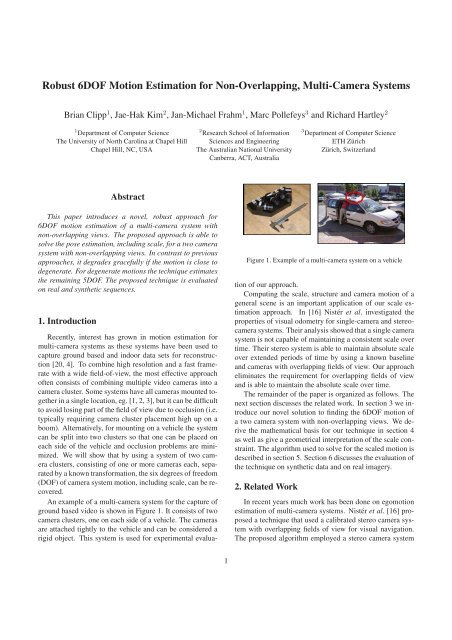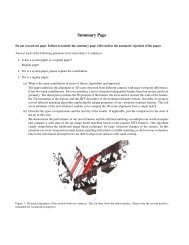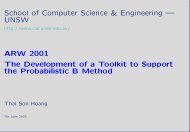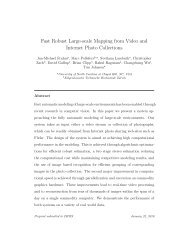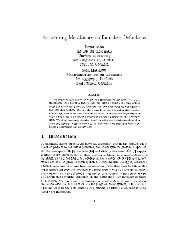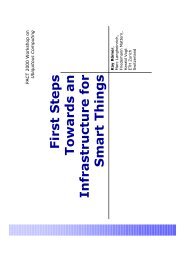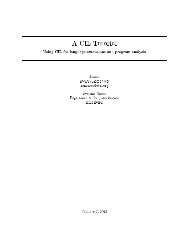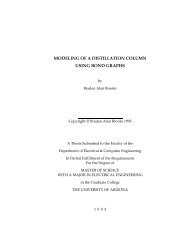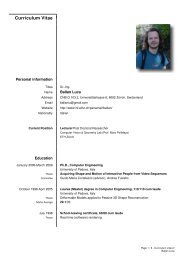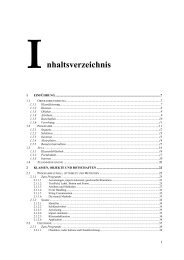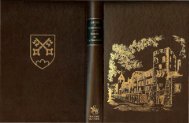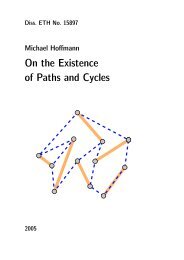Robust 6DOF Motion Estimation for Non-Overlapping, Multi-Camera ...
Robust 6DOF Motion Estimation for Non-Overlapping, Multi-Camera ...
Robust 6DOF Motion Estimation for Non-Overlapping, Multi-Camera ...
Create successful ePaper yourself
Turn your PDF publications into a flip-book with our unique Google optimized e-Paper software.
<strong>Robust</strong> <strong>6DOF</strong> <strong>Motion</strong> <strong>Estimation</strong> <strong>for</strong> <strong>Non</strong>-<strong>Overlapping</strong>, <strong>Multi</strong>-<strong>Camera</strong> Systems<br />
Brian Clipp 1 , Jae-Hak Kim 2 , Jan-Michael Frahm 1 , Marc Pollefeys 3 and Richard Hartley 2<br />
1 Department of Computer Science<br />
2 Research School of In<strong>for</strong>mation<br />
3 Department of Computer Science<br />
The University of North Carolina at Chapel Hill Sciences and Engineering ETH Zürich<br />
Chapel Hill, NC, USA The Australian National University Zürich, Switzerland<br />
Canberra, ACT, Australia<br />
Abstract<br />
This paper introduces a novel, robust approach <strong>for</strong><br />
<strong>6DOF</strong> motion estimation of a multi-camera system with<br />
non-overlapping views. The proposed approach is able to<br />
solve the pose estimation, including scale, <strong>for</strong> a two camera<br />
system with non-overlapping views. In contrast to previous<br />
approaches, it degrades gracefully if the motion is close to<br />
degenerate. For degenerate motions the technique estimates<br />
the remaining 5DOF. The proposed technique is evaluated<br />
on real and synthetic sequences.<br />
1. Introduction<br />
Recently, interest has grown in motion estimation <strong>for</strong><br />
multi-camera systems as these systems have been used to<br />
capture ground based and indoor data sets <strong>for</strong> reconstruction<br />
[20, 4]. To combine high resolution and a fast framerate<br />
with a wide field-of-view, the most effective approach<br />
often consists of combining multiple video cameras into a<br />
camera cluster. Some systems have all cameras mounted together<br />
in a single location, eg. [1, 2, 3], but it can be difficult<br />
to avoid losing part of the field of view due to occlusion (i.e.<br />
typically requiring camera cluster placement high up on a<br />
boom). Alternatively, <strong>for</strong> mounting on a vehicle the system<br />
can be split into two clusters so that one can be placed on<br />
each side of the vehicle and occlusion problems are minimized.<br />
We will show that by using a system of two camera<br />
clusters, consisting of one or more cameras each, separated<br />
by a known trans<strong>for</strong>mation, the six degrees of freedom<br />
(DOF) of camera system motion, including scale, can be recovered.<br />
An example of a multi-camera system <strong>for</strong> the capture of<br />
ground based video is shown in Figure 1. It consists of two<br />
camera clusters, one on each side of a vehicle. The cameras<br />
are attached tightly to the vehicle and can be considered a<br />
rigid object. This system is used <strong>for</strong> experimental evalua-<br />
Figure 1. Example of a multi-camera system on a vehicle<br />
tion of our approach.<br />
Computing the scale, structure and camera motion of a<br />
general scene is an important application of our scale estimation<br />
approach. In [16] Nistér et al. investigated the<br />
properties of visual odometry <strong>for</strong> single-camera and stereocamera<br />
systems. Their analysis showed that a single camera<br />
system is not capable of maintaining a consistent scale over<br />
time. Their stereo system is able to maintain absolute scale<br />
over extended periods of time by using a known baseline<br />
and cameras with overlapping fields of view. Our approach<br />
eliminates the requirement <strong>for</strong> overlapping fields of view<br />
and is able to maintain the absolute scale over time.<br />
The remainder of the paper is organized as follows. The<br />
next section discusses the related work. In section 3 we introduce<br />
our novel solution to finding the <strong>6DOF</strong> motion of<br />
a two camera system with non-overlapping views. We derive<br />
the mathematical basis <strong>for</strong> our technique in section 4<br />
as well as give a geometrical interpretation of the scale constraint.<br />
The algorithm used to solve <strong>for</strong> the scaled motion is<br />
described in section 5. Section 6 discusses the evaluation of<br />
the technique on synthetic data and on real imagery.<br />
2. Related Work<br />
In recent years much work has been done on egomotion<br />
estimation of multi-camera systems. Nistér et al. [16]proposed<br />
a technique that used a calibrated stereo camera system<br />
with overlapping fields of view <strong>for</strong> visual navigation.<br />
The proposed algorithm employed a stereo camera system<br />
1
to recover 3D world points up to an unknown Euclidean<br />
trans<strong>for</strong>mation. In [9] Frahm et al. introduced a <strong>6DOF</strong><br />
estimation technique using a multi-camera system. Their<br />
approach assumed overlapping camera views to obtain the<br />
scale of the camera motion. In contrast, our technique does<br />
not require any overlapping views. In [19] Tariq and Dellaert<br />
proposed a <strong>6DOF</strong> tracker <strong>for</strong> a multi-camera system<br />
<strong>for</strong> head tracking. Their multi-camera motion estimation is<br />
based on known 3D fiducials. The position of the multicamera<br />
system is computed from the fiducial positions with<br />
a MAP based optimization. Our algorithm does not require<br />
any in<strong>for</strong>mation about the observed scene. There<strong>for</strong>e, it has<br />
a much broader field of application.<br />
Another class of approaches is based on the generalized<br />
camera model [10, 17] of which a stereo/multi-camera system<br />
is a special case. A generalized camera is a camera<br />
which can have different centers of projection <strong>for</strong> each point<br />
in the world space. An approach to the motion estimation of<br />
a generalized camera was proposed by Stewénius et al.[18].<br />
They showed that there are up to 64 solutions <strong>for</strong> the relative<br />
position of two generalized cameras given 6 point correspondences.<br />
Their method delivers a rotation, translation<br />
and scale of a freely moving generalized camera. One of<br />
the limitations of their approach is that centers of projection<br />
cannot be collinear. This limitation naturally excludes all<br />
two camera systems as well as a system of two camera clusters<br />
where the cameras of the cluster have approximately<br />
the same center of projection. In [12] motion estimation<br />
<strong>for</strong> non-overlapping cameras was solved by trans<strong>for</strong>ming it<br />
into the well known triangulation problem. The next section<br />
will introduce our novel approach to estimating the <strong>6DOF</strong><br />
motion of commonly used two/multi camera systems.<br />
3. <strong>6DOF</strong> <strong>Multi</strong>-camera <strong>Motion</strong><br />
The proposed approach addresses the <strong>6DOF</strong> motion estimation<br />
of multi-camera systems with non-overlapping<br />
fields of view. Most previous approaches to <strong>6DOF</strong> motion<br />
estimation have used camera configurations with overlapping<br />
fields of view, which allow correspondences to be<br />
triangulated simultaneously across multiple views with a<br />
known, rigid baseline. Our approach uses a temporal baseline<br />
where points are only visible in one camera at a given<br />
time. The difference in the two approaches is illustrated in<br />
figure 2.<br />
Our technique assumes that we can establish at least five<br />
temporal correspondences in one of the cameras and one<br />
temporal correspondence in any additional camera. In practice<br />
this assumption is not a limitation, as a reliable estimation<br />
of camera motion requires multiple correspondences<br />
from each camera due to noise.<br />
The essential matrix which defines the epipolar geometry<br />
of a single freely moving calibrated camera can be estimated<br />
from five points. Nistér proposed an efficient algo-<br />
Figure 2. (a) <strong>Overlapping</strong> stereo camera pair, (b) <strong>Non</strong>-overlapping<br />
multi-camera system<br />
rithm <strong>for</strong> this estimation in [15]. It delivers up to ten valid<br />
solutions <strong>for</strong> the epipolar geometry. The ambiguity can be<br />
eliminated with additional points. With oriented geometry<br />
the rotation and the translation up to scale of the camera<br />
can be extracted from the essential matrix. Consequently a<br />
single camera provides 5DOF of the camera motion. The<br />
remaining degree is the scale of the translation. Given these<br />
5DOF of multi-camera system motion (rotation and translation<br />
direction) we can compensate <strong>for</strong> the rotation of the<br />
system. Our approach is based on the observation that given<br />
the temporal epipolar geometry of one of the cameras, the<br />
position of the epipole in each of the other cameras of the<br />
multi-camera system is restricted to a line in the image.<br />
Hence the scale as the remaining degree of freedom of the<br />
camera motion describes a linear subspace.<br />
In the next section, we derive the mathematical basis of<br />
our approach to motion recovery.<br />
4. Two <strong>Camera</strong> System – Theory<br />
We consider a system involving two cameras, rigidly<br />
coupled with respect to each other. The cameras are assumed<br />
to be calibrated. Figure 3 shows the configuration<br />
of the two-camera system. The cameras are denoted by C 1<br />
and C 2 , at the starting position and C ′ 1 and C ′ 2 after a rigid<br />
motion.<br />
We will consider the motion of the camera-pair to a new<br />
position. Our purpose is to determine the motion using image<br />
measurements. It is possible through standard techniques<br />
to compute the motion of the cameras up to scale,<br />
by determining the motion of just one of the cameras using<br />
point correspondences from that camera. However, from<br />
one camera, motion can be determined only up to scale. The<br />
direction of the camera translation may be determined, but<br />
not the magnitude of the translation. It will be demonstrated<br />
in this paper that a single correspondence from the second<br />
camera is sufficient to determine the scale of the motion,<br />
that is, the magnitude of the translation. This result is summarized<br />
in the following theorem.<br />
Theorem 1. Let a two camera system have initial configuration<br />
determined by camera matrices P 1 = [I | 0]<br />
and P 2 = [R 2 | − R 2 C 2 ]. Suppose it moves rigidly to<br />
a new position <strong>for</strong> which the first camera is specified by<br />
P ′ 1 =[R ′ 1 | − λR ′ 1 C′ 1]. Then the scale of the translation,
λ, is determined by a single point correspondence x ′ ↔ x<br />
seen in the second camera according to the <strong>for</strong>mula<br />
x ′⊤ Ax + λx ′⊤ Bx =0 (1)<br />
where A = R 2 R ′ 1 [(R ′ 1 ⊤ − I)C 2 ] × R 2 ⊤ and B =<br />
R 2 R ′ 1 [C ′ 1] × R 2 ⊤ . In this paper [a] × b denotes the skewsymmetric<br />
matrix inducing the cross product a × b.<br />
Figure 3. <strong>Motion</strong> of a multi-camera system consisting of two<br />
rigidly coupled conventional cameras.<br />
In order to simplify the derivation we assume that the coordinate<br />
system is centered on the initial position of the first<br />
camera, so that P 1 =[I | 0]. Any other coordinate system<br />
is easily trans<strong>for</strong>med to this one by a Euclidean change of<br />
coordinates.<br />
Observe also that after the motion, the first camera has<br />
moved to a new position with camera center at λC ′ 1. The<br />
scale is unknown at this point because in our method we<br />
propose as a first step determining the motion of the cameras<br />
by computing the essential matrix of the first camera<br />
over time. This allows us to compute the motion up to scale<br />
only. Thus the scale λ remains unknown. We now proceed<br />
to derive Theorem 1. Our immediate goal is to determine<br />
the camera matrix <strong>for</strong> the second camera after the motion.<br />
First note that the camera P ′ 1 may be written as<br />
P ′ 1 =[I | 0]<br />
[<br />
R<br />
′<br />
1 −λR ′ 1 C′ 1<br />
0 ⊤ 1<br />
]<br />
= P 1 T .<br />
where the matrix T, is the Euclidean trans<strong>for</strong>mation induced<br />
by the motion of the camera pair. Since the second camera<br />
undergoes the same Euclidean motion, we can compute the<br />
camera P ′ 2 to be<br />
P ′ 2 = P 2 T<br />
[ ]<br />
R<br />
′<br />
1 −λR ′ 1<br />
= [R 2 |−R 2 C 2 ]<br />
C′ 1<br />
0 ⊤ 1<br />
= [R 2 R ′ 1 |−λR 2 R ′ 1 C′ 1 − R 2 C 2 ]<br />
= R 2 R ′ 1[I |−(λC ′ 1 + R ′ 1 ⊤ C 2 )] . (2)<br />
From the <strong>for</strong>m of the two camera matrices P 2 and P ′ 2,we<br />
may compute the essential matrix E 2 <strong>for</strong> the second camera.<br />
E 2 = R 2 R ′ 1[λC ′ 1 + R ′ 1 ⊤ C 2 − C 2 ] × R 2<br />
⊤<br />
= R 2 R ′ 1[R ′ 1 ⊤ C 2 − C 2 ] × R 2 ⊤ + λR 2 R ′ 1[C ′ 1] × R 2 ⊤ (3)<br />
= A + λB .<br />
Now, given a single point correspondence x ′ ↔ x as<br />
seen in the second camera, we may determine the value of<br />
λ, the scale of the camera translation. The essential matrix<br />
equation x ′⊤ E 2 x =0yields x ′⊤ Ax + λx ′⊤ Bx =0, and<br />
hence:<br />
λ = − x′⊤ Ax<br />
(<br />
x ′⊤ Bx = R 2 R ′ 1[R ′<br />
−x′⊤ 1 ⊤ C 2 − C 2 ] × R ) ⊤ 2 x<br />
x ( ′⊤ R 2 R ′ 1 [C′ 1 ] ×R ) (4)<br />
⊤ 2 x<br />
.<br />
So each correspondence in the second camera provides a<br />
measure <strong>for</strong> the scale. In the next section we give a geometric<br />
interpretation <strong>for</strong> this constraint.<br />
4.1. Geometric Interpretation<br />
The situation may be understood via a different geometric<br />
interpretation, shown in Figure 4. We note from (2)<br />
that the second camera moves to a new position C ′ 2(λ) =<br />
R ′ 1 ⊤ C 2 + λC ′ 1. The locus of this point <strong>for</strong> varying values<br />
of λ is a straight line with its direction vector C ′ 1, passing<br />
through the point R ′ 1 ⊤ C 2 . From its new position, the camera<br />
observes a point at position x ′ in its image plane. This<br />
image point corresponds to a ray v ′ along which the 3D<br />
point X must lie. If we think of the camera as moving along<br />
the line C ′ 2(λ) (the locus of possible final positions of the<br />
second camera center), then this ray traces out a plane Π;<br />
the 3D point X must lie on this plane.<br />
On the other hand, the point X is also seen (as image<br />
point x) from the initial position of the second camera, and<br />
hence lies along a ray v through C 2 . The point where this<br />
ray meets the plane Π must be the position of the point X.<br />
In turn this determines the scale factor λ.<br />
4.2. Critical configurations<br />
This geometric interpretation allows us to identify critical<br />
configurations in which the scale factor λ cannot be<br />
determined. As shown in Figure 4, the 3D point X is the<br />
intersection of the plane Π with a ray v through the camera<br />
center C 2 . If the plane does not pass through C 2 , then the<br />
point X can be located as the intersection of plane and ray.<br />
Thus, a critical configuration can only occur when the plane<br />
Π passes through the second camera center, C 2 .<br />
According to the construction, the line C ′ 2(λ) lies on the<br />
plane Π. For different 3D points X, and corresponding image<br />
measurement x ′ , the plane will vary, but always contain<br />
the line C ′ 2(λ). Thus, the planes Π corresponding to different<br />
points X <strong>for</strong>m a pencil of planes hinged around the
Figure 6. Critical motion due to constant rotation rate<br />
Figure 4. The 3D point X must lie on the plane traced out by the<br />
ray corresponding to x ′ <strong>for</strong> different values of the scale λ. Italso<br />
lies on the ray corresponding to x through the initial camera center<br />
C 2.<br />
(R ′ 1 ⊤ C 2 − C 2 ) × C ′ 1 = 0, or rearranging this expression,<br />
and observing that the vector C 2 × C ′ 1 is perpendicular to<br />
the plane of the three camera centers C 2 , C ′ 1 and C 1 (the<br />
last of these being the coordinate origin), we may state:<br />
Theorem 2. The critical condition <strong>for</strong> singularity <strong>for</strong> scale<br />
determination is<br />
(R ′ 1 ⊤ C 2 ) × C ′ 1 = C 2 × C ′ 1 .<br />
Figure 5. Rotation Induced Translation to Translation Angle<br />
axis line C ′ 2(λ). Unless this line actually passes through<br />
C 2 , there will be at least one point X <strong>for</strong> which C 2 does not<br />
lie on the plane Π, and this point can be used to determine<br />
the point X, and hence the scale.<br />
Finally, if the line C ′ 2(λ) passes through the point C 2 ,<br />
then the method will fail. In this case, the ray corresponding<br />
to any point X will lie within the plane Π, and a unique<br />
point of intersection cannot be found.<br />
In summary, if the line C ′ 2(λ) does not pass through the<br />
initial camera center C 2 , almost any point correspondence<br />
x ′ ↔ x may be used to determine the point X and the translation<br />
scale λ. The exceptions are point correspondences<br />
given by points X that lie in the plane defined by the camera<br />
center C 2 and the line C ′ 2(λ) as well as far away points<br />
<strong>for</strong> which Π and v are almost parallel.<br />
If on the other hand, the line C ′ 2(λ) passes through the<br />
center C 2 , then the method will always fail. It may be<br />
seen that this occurs most importantly if there is no camera<br />
rotation, namely R ′ 1 = I. In this case, we see that<br />
C ′ 2(λ) =C 2 + λC ′ 1, which passes through C 2 . It is easy to<br />
give an algebraic condition <strong>for</strong> this critical condition. Since<br />
C ′ 1 is the direction vector of the line, the point C 2 will<br />
lie on the line precisely when the vector R ′ 1 ⊤ C 2 − C 2 is<br />
in the direction C ′ 1. This gives a condition <strong>for</strong> singularity<br />
In particular, the motion is not critical unless the axis of rotation<br />
is perpendicular to the plane determined by the three<br />
camera centers C 2 , C ′ 1 and C 1 .<br />
Intuitively, critical motions occur when the rotation induced<br />
translation R ′ 1 ⊤ C 2 − C 2 is aligned with the translation<br />
C ′ 1. In this case the angle Θ in Fig. 5 is zero. The<br />
most common motion which causes a critical condition is<br />
when the camera system translates but has no rotation. Another<br />
common but less obvious critical motion occurs when<br />
both camera paths move along concentric circles. This configuration<br />
is illustrated in figure 6. A vehicle borne multicamera<br />
system turning at a constant rate undergoes critical<br />
motion, but not when it enters and exits a turn.<br />
Detecting critical motions is important to determining<br />
when the scale estimates are reliable. One method to determine<br />
the criticality of a given motion is to use the approach<br />
of [8]. We need to determine the dimension of the space<br />
which includes our estimate of the scale. To do this we<br />
double the scale λ and measure the difference in the fraction<br />
of inliers to the essential matrix of our initial estimate<br />
and the doubled scale essential matrix. If a large proportion<br />
of inliers are not lost when the scale is doubled then<br />
the scale is not observable from the data. If the scale is observable<br />
the deviation from the estimated scale value would<br />
cause the correspondences to violate the epipolar constraint,<br />
which means they are outliers to the constraint <strong>for</strong> the doubled<br />
scale. When the scale is ambiguous doubling the scale<br />
does not cause correspondences to be classified as outliers.<br />
This method proved to work practically on real data sets.
Figure 7. Algorithm <strong>for</strong> estimating <strong>6DOF</strong> motion of a multicamera<br />
system with non-overlapping fields of view.<br />
5. Algorithm<br />
Figure 7 shows an algorithm to solve relative motion<br />
of two generalized cameras from 6 rays with two centers<br />
where 5 rays meet one center and sixth ray meets the other<br />
center. First, we use 5 correspondences in one ordinary<br />
camera to estimate an essential matrix between two frames<br />
in time. The algorithm used to estimate the essential matrix<br />
from 5 correspondences is the method by Nistér [15]. It<br />
is also possible to use a simpler algorithm which gives the<br />
same result developed by Li and Hartley [13]. The 5 correspondences<br />
are selected by the RANSAC (Random Sample<br />
Consensus) algorithm [7]. The distance between a selected<br />
feature and its corresponding epipolar line is used as an inlier<br />
criterion in the RANSAC algorithm. The essential matrix<br />
is decomposed into a skew-symmetric matrix of translation<br />
and a rotation matrix. When decomposing the essential<br />
matrix into rotation and translation the chirality constraint<br />
is used to determine the correct configuration [11]. At this<br />
point the translation is recovered up to scale.<br />
To find the scale of translation, we use Eq. 4 with<br />
RANSAC. One correspondence is randomly selected from<br />
the second camera and is used to calculate a scale value<br />
based on the constraint given in Eq. 4. We have also used<br />
a variant of the pbM-Estimator [6] to find the initial scale<br />
estimate with similar results and speed to the RANSAC approach.<br />
This approach <strong>for</strong>ms a continuous function based<br />
on the discrete scale estimates from each of the correspondences<br />
in the second camera and selects the maximum of<br />
that continuous function as the initial scale estimate.<br />
Based on this scale factor, the translation direction and<br />
rotation of the first camera, and the known extrinsics between<br />
the cameras, an essential matrix is generated <strong>for</strong> the<br />
second camera. Inlier correspondences in the second camera<br />
are then determined based on their distance to the epipolar<br />
lines. A linear least squares calculation of the scale<br />
factor is then made with all of the inlier correspondences<br />
from the second camera. This linear solution is refined<br />
with a non-linear minimization technique using the GNC<br />
function [5] which takes into account the influence of all<br />
correspondences, not just the inliers of the RANSAC sample,<br />
in calculating the error. This error function measures<br />
the distance of all correspondences to their epipolar lines<br />
and smoothly varies between zero <strong>for</strong> perfect correspondence<br />
and one <strong>for</strong> an outlier with distance to the epipolar<br />
line greater than some threshold. One could just as easily<br />
take single pixel steps from the initial linear solution in the<br />
direction which maximizes inliers, or equivalently minimizing<br />
the robust error function. The non-linear minimization<br />
simply allows us to select step sizes depending on the sampled<br />
Jacobian of the error function, which should converge<br />
faster than single pixel steps and allows <strong>for</strong> sub-pixel precision.<br />
Following refinement of the scale estimate, the inlier correspondences<br />
of the second camera are calculated and their<br />
number is used to score the current RANSAC solution. The<br />
final stage in the scale estimation algorithm is a bundle adjustment<br />
of the multi-camera system’s motion. Inliers are<br />
calculated <strong>for</strong> both cameras and they are used in a bundle<br />
adjustment refining the rotation and scaled translation of the<br />
total, multi-camera system.<br />
While this algorithm is described <strong>for</strong> a system consisting<br />
of two cameras it is relatively simple to extend the algorithm<br />
to use any number of rigidly mounted cameras. The<br />
RANSAC <strong>for</strong> the initial scale estimate, initial linear solution<br />
and non-linear refinement are per<strong>for</strong>med over correspondences<br />
from all cameras other than the camera used in<br />
the five point pose estimate. The final bundle adjustment is<br />
then per<strong>for</strong>med over all of the system’s cameras.<br />
6. Experiments<br />
We begin with results using synthetic data to show the algorithm’s<br />
per<strong>for</strong>mance over varying levels of noise and different<br />
camera system motions. Following these results we<br />
show the system operating on real data and measure its per<strong>for</strong>mance<br />
using data from a GPS/INS (inertial navigation<br />
system). The GPS/INS measurements are post processed<br />
and are accurate to 4cm in position and 0.03 degrees in rotation,<br />
providing a good basis <strong>for</strong> error analysis.<br />
6.1. Synthetic Data<br />
We use results on synthetic data to demonstrate the per<strong>for</strong>mance<br />
of the <strong>6DOF</strong> motion estimate in the presence of<br />
varying levels of gaussian noise on the correspondences<br />
over a variety of motions. A set of 3D points was generated<br />
within the walls of an axis-aligned cube. Each cube wall<br />
consisted of 5000 3D points randomly distributed within a<br />
20m x 20m x 0.5m volume. The two-camera system, which<br />
has an inter-camera distance of 1.9m,a100 o angle between
Figure 8. Angle Between True and Estimated Rotations, Synthetic<br />
Results of 100 Samples Using Two <strong>Camera</strong>s<br />
Figure 10. Scaled Translation Vector Error, Synthetic Results of<br />
100 Samples Using Two <strong>Camera</strong>s<br />
Figure 9. Angle Between True and Estimated Translation Vectors,<br />
Synthetic Results of 100 Samples Using Two <strong>Camera</strong>s<br />
Figure 11. Scale Ratio, Synthetic Results of 100 Samples Using<br />
Two <strong>Camera</strong>s<br />
optical axes and non-overlapping fields of view, is initially<br />
positioned at the center of the cube, with identity rotation.<br />
A random motion <strong>for</strong> the camera system was then generated.<br />
The camera system’s rotation was generated from a<br />
uni<strong>for</strong>m ±6 o distribution sampled independently in each<br />
Euler angle. Additionally, the system was translated by a<br />
uni<strong>for</strong>mly distributed distance of 0.4m to 0.6m in a random<br />
direction. A check <strong>for</strong> degenerate motion is per<strong>for</strong>med by<br />
measuring the distance between the epipole of the second<br />
camera (see Fig. 3) due to rotation of the camera system and<br />
the epipole due to the combination of rotation and translation.<br />
Only results of non-degenerate motions with epipole<br />
separations equivalent to a 5 o angle between the translation<br />
vector and the rotation induced translation vector(see Fig. 5)<br />
are shown. Results are given <strong>for</strong> 100 sample motions <strong>for</strong><br />
each of the different values of normally distributed, zero<br />
mean Gaussian white noise added to the projections of the<br />
3D points into the system’s cameras. The synthetic cameras<br />
have calibration matrices and fields of view which match<br />
the cameras used in our real multi-camera system. Each<br />
real camera has an approximately 40 o x 30 o field of view<br />
and a resolution of 1024 x 768 pixels.<br />
Results on synthetic data are shown in figures 8 to<br />
11. One can see that the system is able to estimate the<br />
rotation (Fig. 8) and translation direction (Fig. 9) well<br />
given noise levels that could be expected using a 2D feature<br />
tracker on real data. Figure 10 shows a plot of<br />
‖T est − T true ‖ / ‖T true ‖. This ratio measures both the accuracy<br />
of the estimated translation direction, as well as<br />
the scale of the translation and would ideally have a value<br />
of zero because the true and estimated translation vectors<br />
would be the same. Given the challenges of translation estimation<br />
and the precise rotation estimation we use this ratio<br />
as the primary per<strong>for</strong>mance metric <strong>for</strong> the <strong>6DOF</strong> motion estimation<br />
algorithm. The translation vector ratio along with<br />
the rotation error plot demonstrate that the novel system per<strong>for</strong>ms<br />
well given a level of noise that could be expected in<br />
real tracking results.<br />
6.2. Real data<br />
For a per<strong>for</strong>mance analysis on real data we collected<br />
video using an eight camera system mounted on a vehicle.<br />
The system included a highly accurate GPS/INS unit which<br />
allows comparisons of the scaled camera system motion calculated<br />
with our method to ground truth measurements. The<br />
eight cameras have almost no overlap to maximize the total<br />
field of view and are arranged in two clusters facing toward<br />
the opposite sides of the vehicle. In each cluster the camera<br />
centers are within 25cm of each other. A camera cluster is<br />
shown in Fig. 1. The camera clusters are separated by approximately<br />
1.9m and the line between the camera clusters<br />
is approximately parallel with the rear axle of the vehicle.<br />
Three of the four cameras in each cluster cover a horizontal<br />
field of view on each side of the vehicle of approximately<br />
120 o x 30 o . A fourth camera points to the side of the vehicle<br />
and upward. Its principle axis has an angle of 30 o with<br />
the horizontal plane of the vehicle which is colinear with<br />
the optical axes of the other three cameras.
Figure 12. Angle Between True and Estimated Translation Vectors,<br />
Real Data with Six <strong>Camera</strong>s<br />
Figure 15. Scaled Translation Vector Difference from Ground<br />
Truth, Real Data with Six <strong>Camera</strong>s<br />
‖T est−T true‖<br />
‖T true‖<br />
0.23 ± 0.19<br />
‖T est‖<br />
‖T true‖<br />
0.90 ± 0.28<br />
Table 1. Relative translation vector error including angle and error<br />
of relative translation vector length mean ± std.dev.<br />
Figure 13. Angle Between True and Estimated Rotations, Real<br />
Data with Six <strong>Camera</strong>s<br />
Figure 14. Scale Ratio, Real Data with Six <strong>Camera</strong>s<br />
In these results on real data we take advantage of the<br />
fact that we have six horizontal cameras and use all of the<br />
cameras to calculate the <strong>6DOF</strong> system motion. The upward<br />
facing cameras were not used because they only recorded<br />
sky in the sequence. For each pair of frames recorded at<br />
different times, each camera in turn is selected and the five<br />
point pose estimate is per<strong>for</strong>med <strong>for</strong> that camera using correspondences<br />
found using a KLT [14] 2D feature tracker.<br />
The other cameras are then used to calculate the scaled motion<br />
of the camera system using the five point estimate from<br />
the selected camera as an initial estimate of the camera system<br />
rotation and translation direction. The <strong>6DOF</strong> motion<br />
solution <strong>for</strong> each camera selected <strong>for</strong> the five point estimate<br />
is scored according to the fraction of inliers of all other cameras.<br />
The motion with the largest fraction of inliers is selected<br />
as the <strong>6DOF</strong> motion <strong>for</strong> the camera system.<br />
In table 1 we show the effect of critical motions described<br />
in section 4.2 over a sequence of 200 frames. Crit-<br />
ical motions were detected using the QDEGSAC [8] approach<br />
described in that section. Even with critical motion<br />
the system degrades to the standard 5DOF motion estimation<br />
from a single camera and only the scale remains ambiguous<br />
as shown by the translation direction and rotation<br />
angle error in Figures 12 and 13. This graceful degradation<br />
to the one camera motion estimation solution means that the<br />
algorithm solves <strong>for</strong> all of the possible degrees of freedom<br />
of motion given the data provided to it.<br />
In this particular experiment the system appears to consistently<br />
underestimate the scale with our multi-camera system<br />
when the motion is non-critical. This is likely due to a<br />
combination of error in the camera system extrinsics and<br />
error in the GPS/INS ground truth measurements.<br />
Figure 16 shows the path of the vehicle mounted multicamera<br />
system and locations where the scale can be estimated.<br />
From the map it is clear that the scale cannot be<br />
estimated in straight segments as well as in smooth turns.<br />
This is due to the constant rotation rate critical motion condition<br />
described in section 4.2. We selected a small section<br />
of the camera path circled in figure 16 and used a calibrated<br />
structure from motion (SfM) system similar to the system<br />
used in [15] to reconstruct the motion of one of the system’s<br />
cameras. For a ground truth measure of scale error<br />
accumulation we scaled the distance traveled by a camera<br />
between two frames at the beginning of this reconstruction<br />
to match the true scale of the camera motion according to<br />
the GPS/INS measurements. Figure 17 shows how error<br />
in the scale accumulates over the 200 frames (recorded at<br />
30 frames per second) of the reconstruction. We then processed<br />
the scale estimates from the <strong>6DOF</strong> motion estimation<br />
system with a Kalman filter to determine the scale of<br />
the camera’s motion over many frames and measured the<br />
error in the SfM reconstruction scale using only our algorithm’s<br />
scale measurements. The scale drift estimates from
Figure 16. Map of vehicle motion showing points where scale can<br />
be estimated<br />
Figure 17. Scaled structure from motion reconstruction<br />
the <strong>6DOF</strong> motion estimation algorithm clearly measure the<br />
scale drift and provide a measure of absolute scale.<br />
7. Conclusion<br />
We have introduced a novel algorithm that determines<br />
the <strong>6DOF</strong> motion of a multi-camera system with nonoverlapping<br />
fields of view. We have provided a complete<br />
analysis of the critical motions of the multi-camera system<br />
that make the absolute scale unobservable. Our algorithm<br />
can detect these critical motions and gracefully degrades to<br />
the estimation of the epipolar geometry. We have demonstrated<br />
the per<strong>for</strong>mance of our solution through both synthetic<br />
and real motion sequences. Additionally, we embedded<br />
our novel algorithm in a structure from motion system<br />
to demonstrate that our technique allows the determination<br />
absolute scale without requiring overlapping fields of view.<br />
References<br />
[1] Immersive Media <strong>Camera</strong> Systems Dodeca 2360,http://<br />
www.immersivemedia.com/.<br />
[2] Imove GeoView 3000, http://www.imoveinc.com/<br />
geoview.php.<br />
[3] Point Grey Research Ladybug2, http://www.ptgrey.<br />
com/products/ladybug2/index.asp.<br />
[4] A. Akbarzadeh, J.-M. Frahm, P. Mordohai, B. Clipp, C. Engels,<br />
D. Gallup, P. Merrell, M. Phelps, S. Sinha, B. Talton,<br />
L. Wang, Q. Yang, H. Stewenius, R. Yang, G. Welch,<br />
H. Towles, D. Nister, and M. Pollefeys. Towards urban 3d<br />
reconstruction from video. In Proceedings of 3DPVT, 2006.<br />
[5] A.BlakeandA.Zisserman. Visual reconstruction. MIT<br />
Press, Cambridge, MA, USA, 1987.<br />
[6] H. Chen and P. Meer. <strong>Robust</strong> regression with projection<br />
based m-estimators. In 9th ICCV, volume 2, pages 878–885,<br />
2003.<br />
[7] M. A. Fischler and R. C. Bolles. Random sample consensus:<br />
a paradigm <strong>for</strong> model fitting with applications to image analysis<br />
and automated cartography. Commun. ACM, 24(6):381–<br />
395, 1981.<br />
[8] J. Frahm and M. Pollefeys. Ransac <strong>for</strong> (quasi-)degenerate<br />
data (qdegsac). pages I: 453–460, 2006.<br />
[9] J.-M. Frahm, K. Köser, and R. Koch. Pose estimation <strong>for</strong><br />
<strong>Multi</strong>-<strong>Camera</strong> Systems. In DAGM, 2004.<br />
[10] M. D. Grossberg and S. K. Nayar. A general imaging model<br />
and a method <strong>for</strong> finding its parameters. In ICCV, pages<br />
108–115, 2001.<br />
[11] R. I. Hartley and A. Zisserman. <strong>Multi</strong>ple View Geometry<br />
in Computer Vision. Cambridge University Press, ISBN:<br />
0521540518, second edition, 2004.<br />
[12] J.-H. Kim, J.-M. Frahm, M. Pollefeys, and R. Hartley. Visual<br />
odometry <strong>for</strong> non-overlapping views using second order<br />
cone programming. In ACCV, 2007.<br />
[13] H. Li and R. Hartley. Five-point motion estimation made<br />
easy. In ICPR (1), pages 630–633. IEEE Computer Society,<br />
2006.<br />
[14] B. Lucas and T. Kanade. An Iterative Image Registration<br />
Technique with an Application to Stereo Vision. In Int. Joint<br />
Conf. on Artificial Intelligence, pages 674–679, 1981.<br />
[15] D. Nistér. An efficient solution to the five-point relative<br />
pose problem. In Int. Conf. on Computer Vision and Pattern<br />
Recognition, pages II: 195–202, 2003.<br />
[16] D. Nistér, O. Naroditsky, and J. Bergen. Visual odometry. In<br />
IEEE Computer Society Conference on Computer Vision and<br />
Pattern Recognition, volume 1, pages 652–659, 2004.<br />
[17] R. Pless. Using many cameras as one. In CVPR03, pages II:<br />
587–593, 2003.<br />
[18] H. Stewénius, D. Nistér, M. Oskarsson, and K. Åström. Solutions<br />
to minimal generalized relative pose problems. In<br />
Workshop on Omnidirectional Vision, Beijing China, Oct.<br />
2005.<br />
[19] S. Tariq and F. Dellaert. A <strong>Multi</strong>-<strong>Camera</strong> 6-DOF Pose<br />
Tracker. In IEEE and ACM International Symposium on<br />
Mixed and Augmented Reality (ISMAR), 2004.<br />
[20] M. Uyttendaele, A. Criminisi, S. Kang, S. Winder,<br />
R. Szeliski, and R. Hartley. Image-based interactive exploration<br />
of real-world environments. IEEE Computer Graphics<br />
and Applications, 24(3):52–63, 2004.


